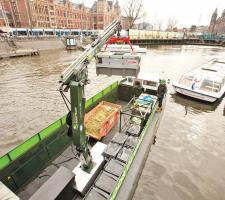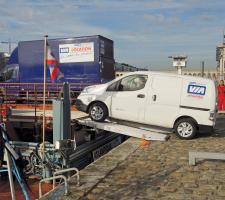
David Crawford looks at an under-utilised solution for city-centre deliveries.
The use of rivers and canals for moving freight is a well-established mode in North Western Europe, where it can take advantage of an intensively developed network. In the Netherlands, 40% of the total volume of goods transported internally goes by water; the figure for Flanders (the neighbouring Dutch-speaking region of Belgium) is 11.5%.
In contrast to heavily congested roads, their waterways have spare capacity to offer; not least since inland fleets have been diminishing since 1960. Recent estimates suggest that, in Flanders alone, some four million tonnes of cargo is at risk of being transferring to already heavily-used roads, with implications for traffic flows, the environment and air quality.
These increased loads would create pressure for further investments in expanding existing interurban route capacity, impacting on urban networks at the point of delivery. Current moves to boost inland waterway use are therefore timely.
Within European cities where scope for expanding road capacity is limited, local governments are restricting heavy truck access times and introducing parking regimes that can fine freight operators heavily for infringements. Alternatives include building freight consolidation centres on city outskirts, from where greener deliveries can run inwards.
One ‘under-investigated’ option for these, says the Belgian University of Antwerp, is the use of urban waterways for making local and last-km deliveries to city-centre businesses and shifting other cargoes including waste. A 2015 report on City Logistics by Water: Good Practices and Scope for Expansion, by the University’s Department of Transport and Regional Economics, highlights relevant developments in locations including Ghent (Belgium), Amsterdam and Utrecht (The Netherlands). Other European centres of innovation are Lille and Paris (France).
A parallel study by the university explores the potential for the wide-scale reactivation of small inland waterways by developing small-barge convoys. It points to the dense network of connecting routes across Belgium, Germany, northern France and the Netherlands, with the environmental costs of using modern electric-powered barges being ‘negligible’.
One successful urban operation, the Beer Boat in Utrecht, delivers drinks and foodstuffs from breweries and food wholesalers to bars and restaurants in the historic centre. The original diesel-powered vessel, introduced to avoid trucks damaging fragile bridges and streets, was replaced in 2010 by the country’s first electrically-powered version as part of the EU-supported 2008-2012 MIMOSA (Making Innovation in MObility and Sustainable Actions) project.
A cost benefit analysis has shown that during the project period, the electric boat saved 38tonnes of CO2 emissions which equated to a 13% decrease for the city centre as a whole. Overall the boat, which is owned by the city, is yielding a net present value (NPV) of more than €420,000 (US$462,000) at a 3.5% discount rate.
Amsterdam, which has introduced environmental zoning and peak noise limitations for commercial vehicles operating within its ring road, has some 25% of its entire urban area covered by canals that have yet to be fully exploited for modern goods distribution. Freight operator
The remaining distance to the customer, which can be as little as 150m, is covered by electric pullers while the reverse logistics journeys carry organic waste from hotels and restaurants to processing plants for biofuel generation. The service has reduced small- and medium-sized truck and van usage in parts of the inner city that can be reached by the barges which have a load capacity of 85m3 (equivalent to that of about four road vehicles).
The company claims that, within the city centre, it can compete with road transport on journey times, due to the freedom from congestion. The operation forms a part of Amsterdam’s Binnenstadservice (inner city service) scheme, a concept for urban goods distribution originally developed in another Dutch city, Nijmegen.
In France, the city of Lille runs a waterborne waste transfer system between the city centre and two recycling plants located to take advantage of the route. And in the run-up to the COP21 UN Climate Change Conference in Paris the city showcased demonstrations of some 20 environment-friendly ‘solutions for our climate’, organised by HAROPA (Ports of Paris).
These included the prototype of a new Distri-Seine barge-based freight delivery service, planned to ply the city’s River Seine.
Developed by inland shipper Compagnie Fluvial de Transports, this involves a vessel with an adapted roll-on-roll-off system which carries electric vans and small trucks (within the city’s new 29m3 limit) into the central area for shop restocking. The barge moors with alternate sides next to existing wharves – meaning the vehicles are always driven forward during the loading and unloading process. In Paris, it moored at the Quai de Bercy, where it loaded and unloaded electric vans supplied by truck renter Via Location, attracting visitors from Belgium and the Netherlands as well as France.
CFT sales director Ferenc Szilagyi told ITS International that the deployed system would have pickup points on the city fringes, near distributors’ depots. One of these could be a few hundred metres from Rungis, the world’s largest wholesale market for fresh produce, which already has its own railway station and junction on the A6 autoroute. “Waterway connections would add an important third option,” he said.
Szilagyi envisages a ‘hop’-style network of up to six in-city stops for offloading incoming trucks and collecting returning empty ones (at convenient pre-arranged stops). Both vessel and trucks would be equipped with vehicle identification and satellite tracking to enable the synchronisation of transfers.
He is currently looking at the potential of introducing similar schemes in other European cities, including London.
As urban waterway freight transport grows in volume, it will be a natural candidate for integration with longer-distance, interurban routes, supported by ITS-based tools developed under the European Commission’s Harmonised River Information Services (RIS) Directive.
This sets out to deliver a competitive alternative to road use as a new partner in the intermodal freight movement chain.
A 2014 report on a 2006-2011 evaluation of countries including Belgium, The Netherlands, France and Germany noted that the RIS concept is now central to inland navigation policymaking inside and beyond and is on the agenda in countries including Brazil, China, India and the US. It stressed, however, the need for more work on the optimisation of logistic processes and modal integration.
- Research studies from the University of Antwerp appear as chapters in Transport of Water versus Transport over Water: Exploring the Dynamic Interplay of Transport and Water, published in 2015 by Springer. ISBN 978-3-319-16132-7 (print); 978-3-319-16133-4 (online).
2 External <?xml version="1.0" encoding="utf-16"?><dictionary /> 0 0 0 oLinkExternal www.springer.com Visit www.springer.com false http://www.springer.com/ false false %>
Simulation and gaming
The Netherlands has over 4,000km of inland waterways, a modern barge fleet and the port of Rotterdam as a gateway into Europe. The
The programme, possibly a world first, has modelled the entire national network of waterways, locks, bridges and fleets in both urban and interurban contexts, using available data. This was used in a series of regional gaming sessions for stakeholders to stimulate discussion about the way forward for inland waterways.
The events discussed ‘hubs’ (with one terminal serving a local network), ‘hops’ (as in the Distri-Seine scheme) and the returning of empty containers.
The exercise demonstrated the scope for halving waiting times, cutting costs by 20%, increasing vessel utilisation by 10% and reducing CO2 emissions by 40%. It also highlighted the need for a new data standard (for exchanging information between operators) and led to new initiatives in Belgium and The Netherlands.
The Rikswaterstaat concludes that the combination of simulation and gaming in an interactive workshop setting has proved to be ‘a very effective way to stimulate discussions on innovation’, attracting widespread interest from well outside the EU.














